
Leopards frequently hunt and eat baboons in the Little Karoo, and most landowners in the region are highly supportive of Cape Leopard conservation. These are two of the findings that surprised Rhodes University’s Dr Gareth Mann during the most detailed study ever undertaken on the Cape Leopard of the Little Karoo.
The study, conducted for his PhD, spanned 3 000 km2 in the Gouritz area, which includes the Swartberg and Gamkaberg cluster of nature reserves, together with privately owned land and farms.
It was conducted from 2010 to 2012 through the Cape Leopard Trust with support from CapeNature. The WWF Nedbank Green Trust funded 40 out of a total of 70 of the study’s camera traps, which were key for the study as the Cape Leopard is highly elusive and rarely seen firsthand by humans.
‘To give you an idea of how elusive they are, out of 12 000 photos taken by our camera traps between March 2011 and August 2012, only 164 were of leopards,’ Dr Mann explains.
The camera traps were set up along routes used by the leopards.
Dr Mann and his team were fortunate to photograph 29 different leopards in the study area, where the population averages at 0,75 leopards per square kilometre. It’s one of the lowest population densities in the country, comparable with densities in the Kalahari.
While the population is low, he says it appears to be stable and that the identification and securing of the leopards’ ‘movement corridors’, linking the core mountain areas of intact natural veld, will play a critical role in the conservation of the Cape Leopard.
During the course of the project Dr Mann collared three male leopards. The collars take a GPS reading every four hours and store the data, which is then SMSed to Dr Mann or remotely downloaded by means of a UHF radio datalink. If the leopard stays on the same spot for more than 24 hours, it typically indicates a kill, which is important for his research as he can then visit the site to see what species the leopard is eating. They regularly kill baboons, as well as klipspringers, duikers and dassies.
‘The prevailing thought is that leopards avoid baboons because they are dangerous, but this does not deter the Little Karoo leopards for whom baboons are a main source of food,’ says Dr Mann.
The reason for this, he believes, is that baboons are the most abundant prey species and the easiest to locate and catch in this highly mountainous terrain. Unlike other parts of South Africa, there are no herds of small antelope such as impala or springbok here.
As regards the landowners, he says that, apart from the inevitable exception, they were extremely interested in participating in the research. ‘When a leopard was caught on camera on someone’s farm they often wore it like a badge of honour of good land management,’ explains Dr Mann, who went out of his way to meet with and interview landowners and to give awareness-raising talks about the leopards at farmers’ meetings.
The average size of stock farms in the area is approximately 3 000 hectares, predominantly game and livestock, including ostrich, sheep and cattle. Farmers experience minimal predation by leopard on ostriches and sheep, which are enclosed in camps in the lower-lying areas.
‘The leopards tend to keep to the higher-lying areas, where the cattle roam and where farmers have lost the odd calf, but fortunately these incidents are fairly rare,’ says Dr Mann. He says he feels greatly privileged to have spent time on the ground with the Cape Leopard – the only member of the Big Five to have survived naturally in the Western Cape.
‘It is a fascinating animal and so little is known about it even though it has lived in these mountains for thousands of years.’
For more information visit capeleopard.org.za.
Information bites
The Little Karoo town of Calitzdorp where Dr Mann was based was the centre of the camera-trap survey area.
The current view is that all African leopards are of the same species, with the exception of those in North Africa. However, because the Cape Leopard is genetically distinct and half the mass of the leopards in the northern parts of South Africa, leopards from game reserves such as the Kruger National Park should not be introduced to the Western Cape.
The male Cape Leopard is more at risk of being killed because its territories cover far greater areas – between 200 and 1 000 km2. By comparison, the average range for a male in the Kruger National Park is 40 km2.
The average range of the female Cape Leopard in the Little Karoo is estimated at between 80 km2 and 180 km2, while that of Kruger female leopards is between 10 km2 and 25 km2.
The average life expectancy of the Cape Leopard in the greater Gouritz region of the Little Karoo is estimated at between 10 and 12 years.
In addition to photographing the leopards, the camera traps have caught several other species. The leopard is an umbrella species that is helping researchers to study and conserve a whole range of species, including indigenous antelope and smaller predators such as honey badgers, African wildcats and caracal.




